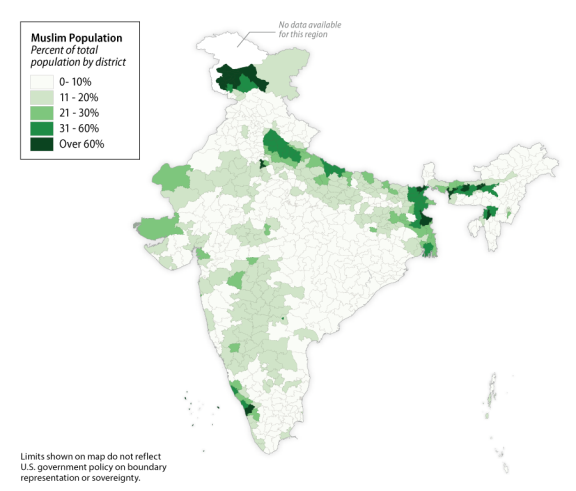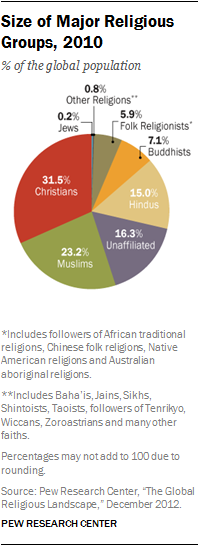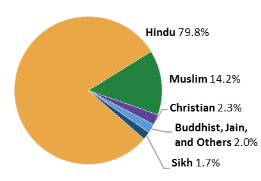Religion In India A Demographic Perspective
Its birth and death rates are both near the global average. The trends reveal first that fertility decline has occurred in all sections of society the poor and the rich the illiterate and the educated residents of villages and towns or cities and in various caste and religion groups.
What Was The Of Muslims In Different States Of India Before And After Partition Quora
In a comparative demographic analysis of two sub-populations for a single census year the question of relative accuracy and coverage would be of greater significance.
Religion in india a demographic perspective. On the other hand Islam has 134 while 23 are practicing Christianity. The other is China. The journal is co-edited by IIASA researcher Vegard Skirbekk an expert in the field of.
In the censuses of British India except in 1941 religion was one prominent criterion for classification of the countrys popula. Religion is a key factor in demography important for projections of future population growth as well as for other social indicators. Table 81 presents the religious composition and growth rates of population by religion in contemporary India.
It then examines the aggregate population composition and growth rates on the basis of religion. This work is however likely to take some time. First viewing a different religious group as an enemy involves an attempt to absolutise religious differences ignoring various other cultural elements and the term communalism which is translated as religious confrontationism is valid as long as it discusses this subjective viewpoint.
Islam is the second-largest religion in India making up 142 of the countrys population with about 172 million adherents 2011 censusIslam is a religion that guides Muslims in every aspect of life not just in specific acts of worship. 11 Second as for secularism which means separation of religion and politics studies have. Once the collection of taluk level data is complete we propose to prepare a Religious Demographic Atlas of India which would offer a graphic presentation of the changing religious demography of India.
India - India - Demographic trends. At the time of the first detailed census in 1881 the adherents of religions of native Indian origin constituted about 79 percent of the population of which 95 percent were Hindus. The Indian subcontinent is the birthplace of four of the worlds major religions.
Do some by religion but the rural-urban incomewealth and caste differences diminish considerably. Its followers share almost 80 in a country population of. Sarkar in New York in October 2017 we shall analyse the age based religious demographics of India.
Religion is a collection of belief systems cultural systems world views that relate humanity to spirituality moral values A global 2012 poll reports that 59 of the worlds population is religious 23 are not religious and 13 are atheists. More than half the population is under age 30 and less than one-fourth is age 45 or older. Religion influences Politics in India 1.
The Hindu religion is predominant in many of these constituents. It has protections for minorities against discrimination on the grounds of religion or caste a strict social stratification based on Hinduism. In the census made in 2001 805 out of the total population of the country are believers of Hinduism.
Religion in India is characterized by a diversity of religious beliefs and practices. Its constitution provides for freedom of conscience and the right to profess practice and propagate religion. Of the remaining about 21 percent of the population that followed religions of alien origin as many as 96 percent were Muslims.
Religious Demographic Atlas of India. India is a country of religious pluralism and cultural diversity. The perpetuation of demographic religions continued in independent Indias categorisation census exercises where the demographic anxieties are paramount and the planks of.
The Preamble to the Constitution of India states that India is a secular state and pleas to the Supreme Court to remove the words secular and socialist from the constitution have been rejected. These religions are also all classified as Eastern religions. Religion Census of India 2001 At the census 2001 out of 1028 million population little over 827 million 805 have returned themselves as followers of Hindu religion 138 million 134 as Muslims or the followers of Islam 24 million 23 as Christians 19 million 19 as Sikh 8 million 080 as Buddhists and 4 million 04 are Jain.
Religious Demography of India I NDIA is one of the only two regions of the world where a great human civilisation took birth several millennia ago and has survived more or less uninterrupted to this day. Muslims comprise 134 per cent 138 million of the total population according to 2001. Religion in India Breakdown.
Religion and State. In this article based on a talk given by Prof. In this article we examine how the Indic population by this we refer to practitioners of the religions that arose in.
A new journal Yearbook of International Religious Demography is the first to bring a quantitative demographic focus to the study of religion. Religion in India A Demographic Perspective This paper estimzates religionwise population data for Assam in 1981 andfor Jammu and Kashmir in 1991. Tribal Demography of India.
Indian religions sometimes also termed Dharmic religions or Indic religions are the religions that originated in the Indian subcontinent. Life expectancy is about 68 for men and 70 for women. 19 of the population believes in Sikhism 08 is the number of Buddhists and Jainism has 04 believers.
Namely Hinduism Jainism Buddhism and Sikhism. This largest democracy is combination of 28 full-fledged States and 8 Union Territories at present. It also analyses the child sex ratios for diffrrent religious communities and wherever necessary the.
Religions In India - The spiritual land of India has given birth to many religions such as Hinduism Sikhism Jainism and Buddhism. Indias population is young. 2 India is a religiously pluralistic and multiethnic democracy the largest in the world.
Probably an equally great civilisation arose in the Americas and flourished for long. For India if fertility differentials were constant and there was no increase in educational enrolment the Indian population would grow from 846 million in 2000 to more than 23 billion in 2050 while the Hindu population would change from 802 to 764 and the proportion of Muslims would rise from 134 to 19.

With Current Trends It Will Take 220 Years For India S Muslim Population To Equal Hindu Numbers

A Religious Map Of India By Cecile Marin Le Monde Diplomatique English Edition July 2019

India Religious Freedom Issues Everycrsreport Com

Religious Diversity Around The World Pew Research Center

India Religious Freedom Issues Everycrsreport Com

India Population 2020 In Crores By Religion

Population Growth Of Religions In India 1950 2020 Youtube


Posting Komentar untuk "Religion In India A Demographic Perspective"